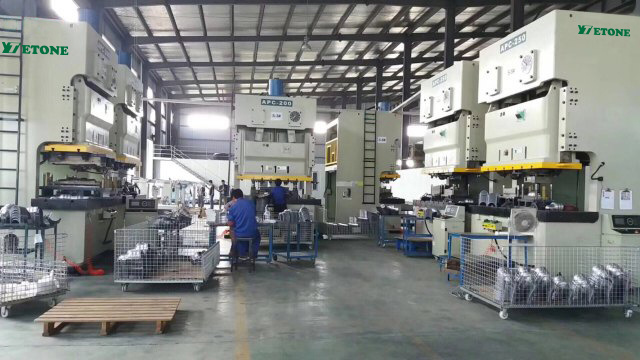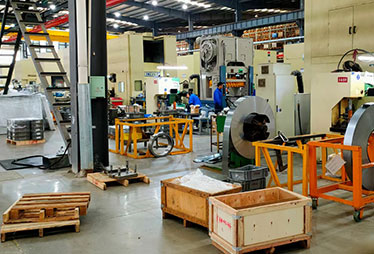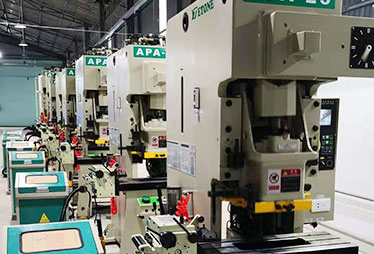The structure of high speed punch
2022-08-18
The high speed punch guide sleeve is a tubular part that provides precise guidance for the relative movement of the upper and lower die bases. Most of them are fixed in the upper die base and used in conjunction with the guide posts fixed on the lower die base. The guide plate is a plate-shaped part with an inner hole that precisely fits with the punch, which is used to ensure the mutual alignment of the punch and the punch, and to discharge (pieces). The guide post is a cylindrical part that provides precise guidance for the relative movement of the upper and lower die bases. The guide pin is a pin-shaped part that extends into the material hole to guide its position in the die. The guide plate die is a die guided by the guide plate, and the punch does not leave the guide plate when the die is used. The guide plate is a plate-shaped guide part that guides the strip (belt, roll) material into the die. The guide post die set is a die set in which the guide post and the guide sleeve slide against each other. (See "Mold base").
The high speed punching die is a process equipment installed on the press for the production of punching parts. It consists of upper and lower parts that cooperate with each other. The punch is a convex working part in the die that directly forms the punching part, that is, the part whose shape is the working surface. The concave die is a concave working part that directly forms the punching part in the die, that is, the part with the inner shape as the working surface. Guards are plate-like parts that prevent fingers or foreign objects from entering the danger zone of the die. The blanking plate (ring) is a part in the die that is used to press the stamping material or the process part to control the flow of the material. In the drawing die, the blanking plate is mostly called the blanking ring. The pressing rib is a rib-like protrusion used to control the flow of the material in the drawing die or deep drawing die. individual parts. The pressure sill is a special name for the pressure rib with a rectangular cross-section. See "Binder Ribs". The bearing plate is a plate-shaped part used to extend the upper plane of the die and support the stamping material. The continuous die is a die with two or more stations, and the material is fed into one station successively with the stroke of the press, so that the punching piece is gradually formed.
The side edge of the high-speed punch is a punch that cuts out the feeding positioning gap on the side of the strip (belt, coil) material. The side pressure plate is a plate-shaped part that applies pressure to one side of the strip (belt, coil) material through a spring to make the other side close to the guide plate. The ejector is a rod-shaped part that directly or indirectly ejects the process (sequence) piece or sequence material by upward action. The top plate is a plate-like part that moves in the die or module, and directly or indirectly ejects the work (sequence) piece or waste by upward movement. The ring gear is a ring-shaped tooth-shaped protrusion on a fine blanking die or a toothed press plate, and is a local structure of the die or a toothed press plate rather than a separate part. The limit sleeve is a tubular part used to limit the minimum closed height of the die, and is generally sleeved outside the guide post. The limit post is a cylindrical piece that limits the minimum closed height of the die. The positioning pin (plate) is a part that ensures the constant position of the process part in the mold. It is called a positioning pin or a positioning plate because of its different shapes.
The high-speed punch fixing plate is a plate-like part that fixes the punch. The fixed stripper is a stripper that is fixed on the die and does not move. The fixed stopper pin (plate) is a stopper pin that is fixed in the mold. The unloader is a non-plate-shaped part or device that unloads the process (sequence) part from the outer surface of the punch. The stripper is a fixed or movable plate-shaped part that removes the material or process (sequence) piece from the punch. The discharge plate is sometimes integrated with the guide plate, which also acts as a guide, and is still called the discharge plate. The unloading screw is a screw fixed on the spring-loaded release plate to limit the rest position of the spring-loaded release plate.
The high-speed punching sheet process die is a die that only completes one process in one stroke of the press. There are two types of scrap cutters. 1. A cutter installed on the flange trimming die of the deep drawing part to cut off the entire circle of trimming waste for easy removal. 2. A cutter installed on a press or die for cutting strip (belt, roll) waste to fixed lengths for easy removal. Combination punching die is a universal and adjustable complete set of punching die that gradually forms various punching parts according to geometric elements (straight line, angle, arc, hole). The outline of the flat stamping generally requires several sets of combined dies to be punched in stages. The starting stopper pin (plate) is a part used for positioning when the starting end of the material is fed. The initial stopper pins (plates) are all movable. Pieces are individual pieces that make up a complete die, punch, stripper or fixed plate. The stopper (plate) is a hardened part used for positioning when the material cut out by the side edge is fed, and it is also used to balance the single-sided cutting force on the side edge. Blocks (plates) are generally used in conjunction with side blades.
























































